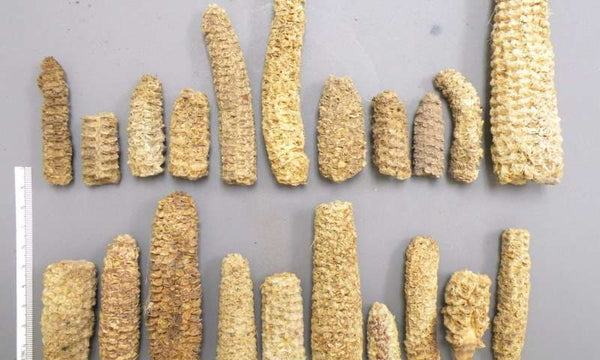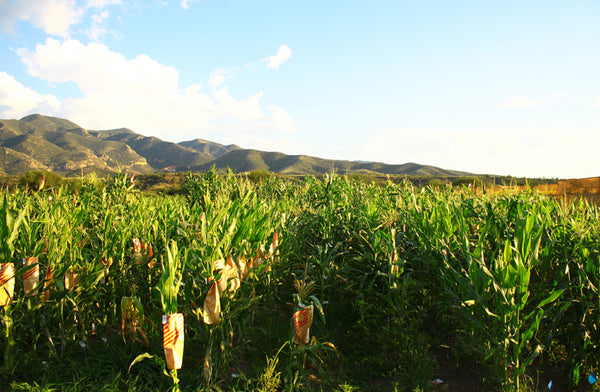
By Melissa Kruse-Peeples, Education Coordinator.
A recently published paper in the journal Science, features research results derived from the Native Seeds/SEARCH maize collection. The international team of researchers concluded that key genetic changes allowed maize to be grown in the U.S. southwest highlands 2,000 years ago, a much colder climate than corn’s tropical origins in the Balsas River Valley of Mexico.
Maize, more commonly known as corn, originated in Mexico and made its way to what is now the southwestern U.S. approximately 4,000 years ago. In doing so, it quickly became one of the most important crops, particularly in the low desert regions of the Southwest. But, as the researchers note, it was not widely adopted to the more temperate high elevation areas of the northern Southwest for another 2,000 years, a development that raised many questions for archaeologists.
To better understand why the delay occurred, the researchers studied samples of 2,000-year-old corn cobs found at the dry-cave site called Turkey Pen Shelter, located at 6000 feet in elevation in Utah's highlands. An excavation in the 1970’s recovered over a dozen preserved corn cobs. The site was used during a time of agricultural intensification and increased reliance on cultivated maize based on other evidence from the site and others dating to a similar time period. It was hypothesized that the maize at Turkey Pen was of a variety that had an early flowering period and therefore matured early allowing for successful growth in upland areas where growing seasons are shorter than the lowland deserts. Flowering in maize occurs when the female flowers (the corn ear) begin to grow their silks and male flowers (the corn tassel) begin to anthesis or drop pollen.

Sampled cobs from Turkey Pen Shelter. Photo courtesy of Bruce Benz.
To learn more about its physical attributes including flowering period, researchers sequenced the genome of the ancient cobs and compared the results to modern maize lines. Over 100 maize accessions from the Native Seeds/SEARCH Seed Bank collection originating from the US Southwest and NW Mexico were used in the research along with data from over 2600 maize lines held at the USDA Agricultural Research Service in Ames, Iowa. This is the first time flowering time, a complex trait controlled by many genes, has been successfully reconstructed from ancient samples and then validated using modern plants.
Based on the genetic comparison of the ancient maize samples to modern maize, the Turkey Pen maize was of a type that flowered early and therefore was relatively fast maturing. Early flowering was a necessity for widespread adoption in high elevation regions. Specifically, the 2,000 year old Turkey Pen maize was just marginally adapted to growing in the climate of Blanding, Utah which has an average frost-free period of 5 months. Comparatively the frost free growing season of the desert lowland regions of the Tucson basin, where widespread maize cultivation was adopted earlier, is nearly twice as long. The maize recovered from the Turkey Pen site is predicted to have flowered 74 days after planting, a similar time frame to most modern temperate lines, and fully matured to dry seed after 150 days. The Turkey Pen maize flowered later than modern Northern Flint lines, which are among some of the earliest modern maize varieties to flower, but this earlier flowering was significant as other contemporaneous maize varieties are assumed to have a much longer period to flowering and would have struggled or been impossible to grow in highland environments with short growing seasons.
The results support the interpretation that the maize varieties introduced from Mexico 4,000 years ago were not preadapted to temperate climates. Rather, adaptation to temperate environment occurred in situ in the Southwest. The maize grown at Turkey Pen Shelter, and ultimately throughout the temperate regions of North America, is the result of local seed savers growing and selecting seeds for temperate climate in the southwestern United States. Much of the maize grown in the United States today is in the temperate Midwestern corn belt and derives from this in situ maize selection in the southwestern United States by ancestral Puebloan people.
“It wasn’t thought possible to pinpoint a trait like flowering time from archaeological samples and it’s only because of recent advances in ancient genomics that we’ve been able to generate these new insights,” says lead author Kelly Swarts from the University of Tübingen. “We discovered incredible genetic variation in ancient maize, but it took so many tweaks of so many genes to grow it in a new climate that it was a hugely protracted process. A trait like flowering time is so complex that it involves changes to hundreds of genes,” she says.
The ancient maize from the Turkey Pen Site cannot be directly phenotyped or the physical traits characterized. All that has been recovered is preserved cobs. But the phenotypes of modern maize are observable and can be correlated to the genetic information of the ancient corn. Based on the phenotypes and genetic code of modern maize samples including those from the Native Seeds/SEARCH collection, the maize grown at the Turkey Pen site 2 were short, bushy plants with many tillers or branches. The kernels were a flint type with a high carotenoid yellow color, important for human nutrition.

Maize accessions growing at the NS/S Conservation Farm in Patagonia in for recording phenotypic information. Photo courtesy of Native Seeds/SEARCH.
This research is interesting from the perspective of understanding the origins of corn agriculture but also highlights the importance of the conservation of biodiversity and the significance of indigenous stewardship. “These exciting results would have been impossible without the continued stewardship of landrace maize by the indigenous farmers who are heirs to the multitude of traits bred by their ancestors,“ says Nicholas Garber the Conservation Program Manager at Native Seeds/SEARCH. “The analyses in this study show another novel value of biodiversity for a conventional agricultural system whose practices actively work to eliminate it."
The complete article is available for download from the Science website. DOI: 10.1126/science.aam9425
Genomic estimation of complex traits reveals ancient maize adaptation to temperate North America
Kelly Swarts, Rafal M. Gutaker, Bruce Benz, Michael Blake, Robert Bukowski, James Holland, Melissa Kruse-Peeples, Nicholas Lepak, Lynda Prim, M. Cinta Romay, Jeffrey Ross-Ibarra, Jose de Jesus Sanchez-Gonzalez, Chris Schmidt, Verena J. Schuenemann, Johannes Krause, R. G. Matson, Detlef Weigel, Edward S. Buckler and Hernán A. Burbano,
Science 357 (6350), 512-515. 2017 Aug 04.
Abstract: By 4000 years ago, people had introduced maize to the southwestern United States; full agriculture was established quickly in the lowland deserts but delayed in the temperate highlands for 2000 years. We test if the earliest upland maize was adapted for early flowering, a characteristic of modern temperate maize. We sequenced fifteen 1900-year-old maize cobs from Turkey Pen Shelter in the temperate Southwest. Indirectly validated genomic models predicted that Turkey Pen maize was marginally adapted with respect to flowering, as well as short, tillering, and segregating for yellow kernel color. Temperate adaptation drove modern population differentiation and was selected in situ from ancient standing variation. Validated prediction of polygenic traits improves our understanding of ancient phenotypes and the dynamics of environmental adaptation.
